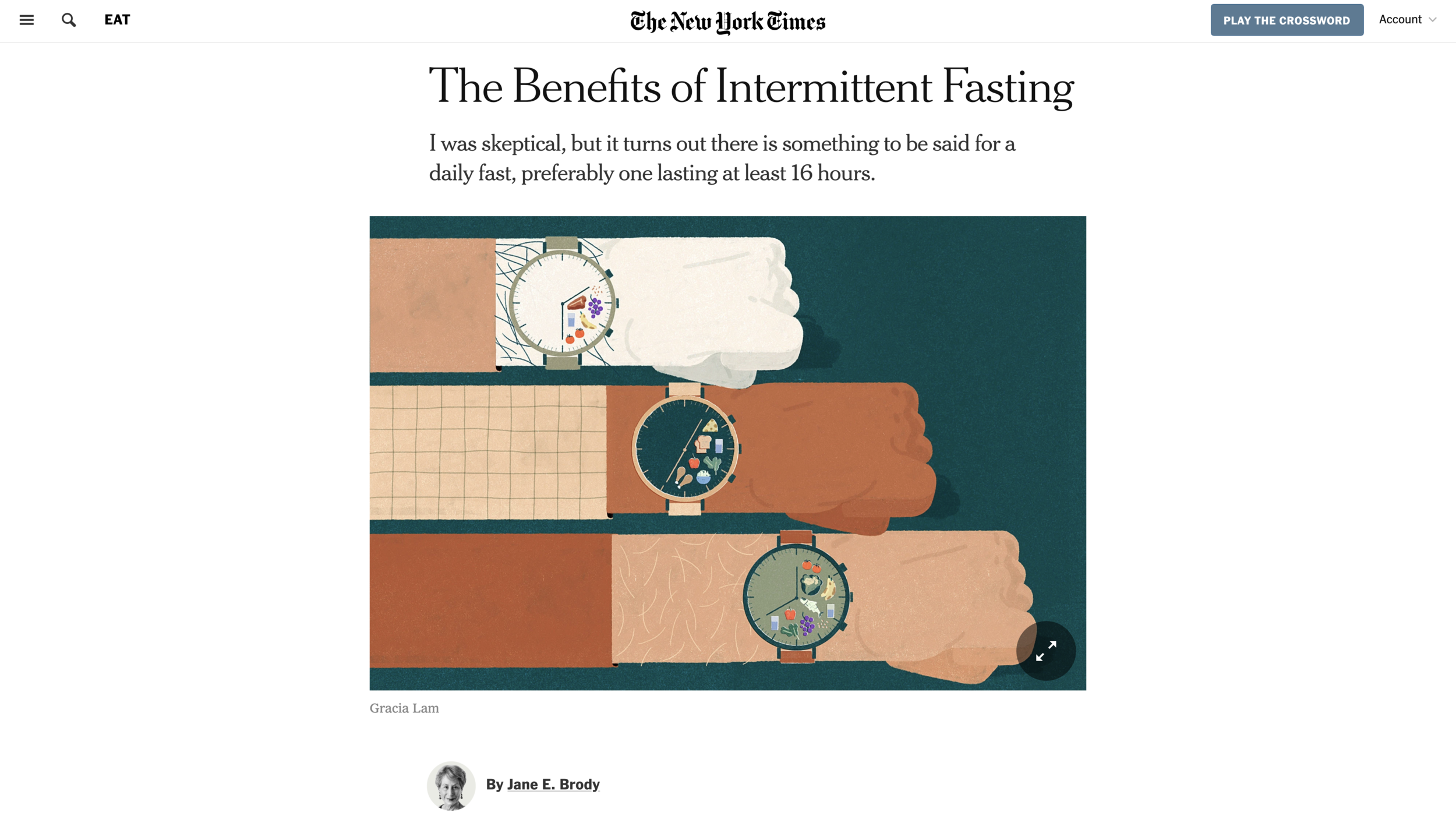Jane Brody on Intermittent Fasting
“Intermittent fasting” is a bit of a redundant phrase. Logically, non-intermittent fasting would mean constant fasting, which is something likely to lead to death after many months of it have burned through all of your fat reserves. Because almost any reasonable use of fasting is therefore “intermittent fasting,” it is not, in practice, anything more than a synonym for “fasting.”
Jane Brody, in “The Benefits of Intermittent Fasting,” uses “intermittent fasting” to refer to limiting one’s daily eating window to no more than 8 hours (say eating only between 11 AM and 7 PM or only between noon and 8 PM) so that one has on average a 16-hour stretch of fasting each day. Evidence suggests that this, like many other uses of fasting, has important health benefits. (All of the quotations below come from Jane Brody’s article “The Benefits of Intermittent Fasting.”
A lot of the evidence about fasting is animal evidence. For example:
… in an animal model of stroke, those fed only intermittently suffered less brain damage because they were better able to resist the stress of oxygen and energy deprivation.
Other animal studies have shown a “robust disease-modifying” benefit of intermittent fasting on “a wide range of chronic disorders, including obesity, diabetes, cardiovascular disease, cancers and neurodegenerative brain diseases,” the researchers reported. Their review of both animal and human studies found improvements in a variety of health indicators and a slowing or reversing of aging and disease processes.
As for human evidence:
… human studies of intermittent fasting found that it improved such disease indicators as insulin resistance, blood fat abnormalities, high blood pressure and inflammation, even independently of weight loss. In patients with multiple sclerosis, intermittent fasting reduced symptoms in just two months, a research team in Baltimore reported in 2018.
Why would fasting be helpful? Jane Brody’s article “The Benefits of Intermittent Fasting” points to a number of different theoretical reasons (bullets added to separate passages):
Mark P. Mattson, neuroscientist at the National Institute on Aging and Johns Hopkins University School of Medicine, explained that the liver stores glucose, which the body uses preferentially for energy before it turns to burning body fat.
“It takes 10 to 12 hours to use up the calories in the liver before a metabolic shift occurs to using stored fat,” Dr. Mattson told me. After meals, glucose is used for energy and fat is stored in fat tissue, but during fasts, once glucose is depleted, fat is broken down and used for energy.
If you think evolutionarily, Dr. Mattson said, predators in the wild fight for prey in the fasting state and are better at recovering from inevitable injuries. The human counterpart — people who evolved in feast-or-famine environments — would not have survived unless somehow protected by fasting.
“Our human ancestors did not consume three regularly spaced large meals, plus snacks, every day, nor did they live a sedentary life,” the researchers wrote. The studies they analyzed showed that “most if not all organ systems respond to intermittent fasting in ways that enable the organism to tolerate or overcome the challenge” and then return to normal.
Dr. Mattson explained that during a fast, the body produces few new proteins, prompting cells to take protein from nonessential sources, break them down and use the amino acids to make new proteins that are essential for survival. Then, after eating, a lot of new proteins are produced in the brain and elsewhere.
That last passage about protein production is somewhat opaque. It points to a bigger benefit of fasting than it sounds. After a high enough dose of fasting—with what is a “high enough dose of fasting” an area of debate—the body begins seriou: cannibalizing substandard cells for spare parts. Autophagy is an important part of the body’s quality control. This crucial type of cellular quality control takes place mainly during fasting. Cellular quality control should be especially helpful toward preventing cancer. (At lower doses of fasting—too low to engender much autophagy proper—cells increase the cannibalization for spare parts of molecules already within them. This is likely to yield at least some fraction of the benefits of autophagy proper.)
The most important place Jane Brody goes off track in her article is in talking about the difficulty of fasting without pointing out that those on a lowcarb, high fat diet find fasting a lot easier and more pleasant. If the body is already in a fat-burning mode burning fat from food, it is easier for it to make the transition to burning body fat if one begins fasting. To be specific about my point, I’ll bet the “hunger, irritability and a reduced ability to concentrate” from fasting that researchers talk about is highly concentrated in those who eat high-carb diets.
The second most important place Jane Brody goes off track is talking about difficulties of social coordination from a limited eating window. She is assuming you need to have an eating window at the same time each day. Au contraire. Evolutionarily, our ancestors faced an environment in which the timing of fasting was random, due to not finding food right away. We are adapted to that. So there is reason to think having one’s eating window move around in its position within the day is a good thing, not a bad thing. And that makes it easy to plan one’s mobile eating window to coincide with social engagements that involve eating. (The big problems will be from the expectations of those in your own household that you will be eating all day long, or whenever they are eating.)
I’m glad to see fasting getting good press. I hope more people take up fasting as a way to improve their health.
For annotated links to other posts on diet and health, see:
